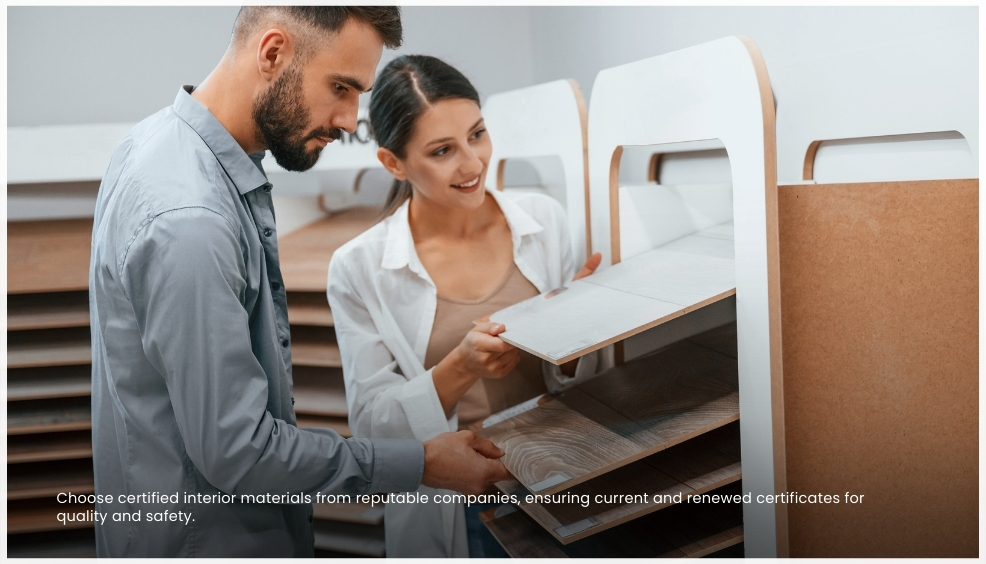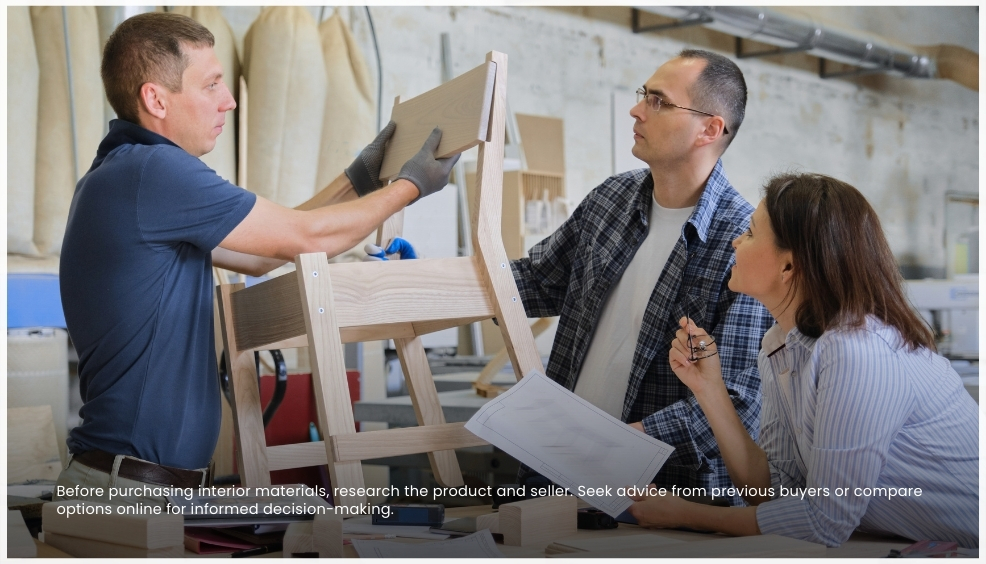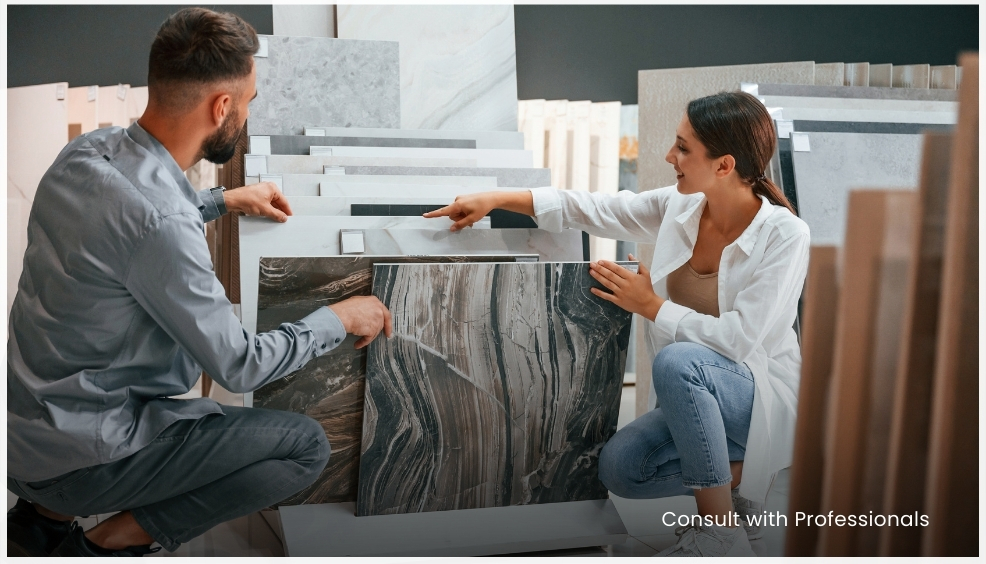
How to differentiate between good interior materials from harmful interior materials
How to differentiate between good interior materials from harmful interior materials
Most often we need clarification as to what is the right option for our interiors. You might wonder what is the right color, the texture that you need to use, and the important part, staying within the budget. When we try to stay within the budget or have a low budget we compromise on choosing good interior materials. Some interior materials can be harmful to the environment and can reduce indoor air quality and overall health. It is important to seek professional advice when choosing interior materials and how often you need to change your interiors. In this blog, we will talk about the characteristics of good interior materials, why it is important to choose good materials, what makes a material harmful, and what you can do to avoid them.
What defines a material good
Various factors determine good interior materials. While selecting materials for any interior space it is important to consider these factors to ensure safety and also attain the aesthetics that you are looking for.
Safety: For any material that we choose we first look into how safe it is to use those products. The same goes for interior design materials as well. Some materials might produce harmful gases that can pollute your surroundings and also affect your health. It is good to choose materials with low or zero volatile organic compound (VOC) emissions. Good interior materials will also be fireproof, especially the materials that are likely used in fire-prone areas.
Functionality: What is the purpose of a material if it cannot be used effectively? It is important to ensure that these materials serve their purpose and also is easy to use by everyone. It should be easy to install. Most times fancy materials might be hard to install and might also fail to serve their purpose. It is important to know if it is easy to install these materials and if it is worth going through the pain. Good interior materials are easy to maintain as well. However good-looking a material is, if not maintained properly it will soon lose its looks.
Sustainability: The longer a material maintains the quality and its functions the better the material is. It should be able to effectively adapt to the environment and also the various design styles. This will help in the flexibility of future design changes and you will not have to constantly invest in new interior materials each time. Good materials will easily withstand constant wear and tear. This will ensure the longevity of the material.
Long-Term values: Fixing a low budget is something we all do in common, but it is important to remember the long-term values of the materials. Investing in high-quality materials might be expensive initially but it can result in cost savings as you will not have to frequently replace the materials and also avoid using materials that emit harmful gases.
Certification: Interior design companies certify their products to sell quality products. These certifications will also help customers trust the product. Good materials will be certified as eco-friendly and also show that it is safe to use.
Importance of choosing good interior materials.
There are times we all feel that it is alright to choose a material that is of low cost or something random just because you feel that it is trending and is used by everyone. This can affect the aesthetics of the interiors or even cause health issues for the people around these materials. Opting for good interior materials that produce low Volatile Organic Compound (VOC) emissions can contribute to better indoor air quality. This is crucial for people who stay indoors more often. Carefully choosing materials is essential for matching the colour scheme of the interiors, where it can be placed and how much of the material is required. This careful selection can enhance the room or office making it more appealing to everyone. The material can be said it be good if it is durable and lasts for a longer period. This will also help you avoid frequent replacement of the materials and reduce wastage of materials. Good interior materials bring a balance between the functionality and the aesthetics of the interiors. If you buy a wardrobe which is made of fancy materials but is hard to open each time then you are not going to be satisfied with the product. Because of this reason, it is important to look at all the aspects before you purchase any material.
What makes a material harmful?
Various factors can make an interior material harmful to people and the environment. It is important to consider these factors before making any purchase. It is good to gain knowledge on these materials from an expert as well. Some of the key elements that can be harmful are discussed below.
Volatile Organic Compounds (VOC): As we discussed earlier some materials emit Volatile Organic Compounds (VOC), into the air. These chemicals might be found in paints, adhesives and finishes. This can reduce the air quality and also cause various health issues for people who are exposed to these chemicals. Houses with kids or elderly people and schools should mainly be careful with the type of materials they use for the interiors.
Formaldehyde Emissions: Some adhesives and resins might contain formaldehyde, a colourless gas. These are found in wood products, carpets and even in soft textile covering such as sofas and armchairs. Prolonged exposure to formaldehyde can cause respiratory irritations. This is also classified as a known carcinogen by some health organizations.
Heavy Metals: Materials that contain heavy metals such as mercury and lead can be avoided while choosing interior materials. These substances can be a high risk to health. Lead is known to cause developmental issues in children. It is important to choose good interior materials that contain less heavy metals and are safe for houses that have small kids.
Allergens: Some interior materials will contain allergens like dust mites and molds which can affect the health of the people. These are mainly found in textiles and soft furniture. People who have respiratory issues might be at more risk if they are exposed to such materials. Some varnishes and finishers that are used as coats might also cause irritation to some people.
Toxic Finishes: Some finishes, varnishes and outer coating might have harmful chemicals mixed. These can cause irritation to the people living there and sometimes these substances might release toxic gas causing poor quality of the air. Buying good interior materials will ensure that these toxic finishes are not used.
Lack of Certifications: If the price is too low for a material then it is better to check if those materials are certified. Materials that do not have certificates or adhere to safety and environmental standards might be risky to use. Having certificates will help the customers also build trust with the company as they are provided with good interior materials.
Understanding these risk factors and making a conscious choice will help you reduce the risk of getting health issues and also get the ideal home interior design.
What you can do to avoid or prevent from having harmful materials
It might not always be easy to find materials that cause no issues. There will be some amount of chemicals which is inevitable. But there are certain things that you can do to avoid buying highly harmful materials and also choose good interior materials.
Research and Educate: Before you buy anything it is good to conduct basic research on the product and the place you buy it from. You can ask people who have already bought the interior materials that you are planning on buying or you can check online and compare the materials. You can look for the type of certificate that the material has and also the quality of the material.
Choose low-VOC or VOC-free materials: Good interior materials will contain a low level of VOC or it will be VOC-free material. You can look for products that explicitly mention compliance with green building standards
Buy materials that are certified: A company that shows a certificate for their interior materials will make sure that they give you products that will not cause major health issues. You check if the certificates are from a reputable organization and also how old the certificates are. To ensure that you are given good interior materials companies will renew their certificate.
Opt for natural and renewable materials: It is always best to choose interior materials that are from natural and renewable sources. These will have low environmental impacts. Some of the resources that these materials come from are bamboo, wood, cork or reclaimed wood
Avoid Formaldehyde-Based Products: When you choose good interior materials check if they contain formaldehyde, especially materials that are made from wood. You can always look for an alternative for these products.
Check for Heavy Metals: It is always best to verify if the interior materials contain any heavy metals, especially in the paints and finishes that are used in the interior materials. Good interior materials will contain no heavy metals or they might have very little content in them.
Consider Allergen-Free products: If you are someone who has respiratory issues or any allergies it is better to choose materials that do not contain these allergens. This also includes choosing hypoallergenic textiles and materials that can be easily cleaned.
Consider Changing or cleaning the materials: If the material gets old it is best to get new interior materials. This way you can prevent the materials from polluting the inside air. It is also good to clean these materials as frequently as possible which will keep the material retain the quality for a longer period of time.
Author
adminRelated posts
How to choose the best plywood for interiors
How to choose the best plywood for interiors Every house has its aesthetics depe
10 Reasons why Aauric is the first choice for interior designers in Bangalore
10 Reasons why Aauric is the first choice for interior designers in Bangalore AA
Significant things you need to know about the best plywood for wardrobe
Significant things you need to know about the best plywood for wardrobe Building
13 Comments
Comments are closed.











Pingback: rybelsus prices